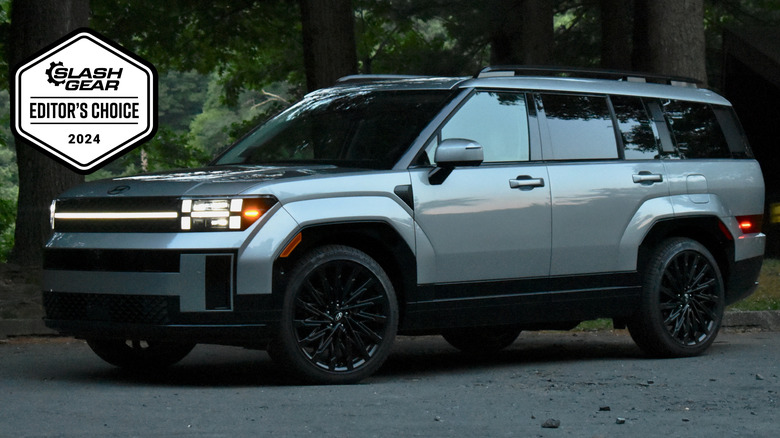
Stephen Edelstein/SlashGear
EDITORS’ RATING : 9 / 10
- Distinctive styling
- Pleasant to drive
- Well-designed interior
- Reasonably priced
- Transmission shifts roughly at low speeds
- Cramped third row
Hyundai is an automaker unmoored from history. While it’s been making cars since the 1960s, until recently they were cars nobody cared about. The Santa Fe is what passes for an august nameplate in Hyundai lore. It was the automaker’s first SUV, and helped lead Hyundai’s coming of age in the early 2000s by combining excellent build quality and a generous warranty with lower pricing than rival Japanese products. But it doesn’t inspire nostalgia.
This lack of a legacy created an opportunity for Hyundai. Whereas other automakers are shackled by history and customer expectations, Hyundai has been free to make the Santa Fe whatever it wants. Over the years the Santa Fe has gotten bigger and chased the automotive styling trends of the moment. Nobody cared that the new Santa Fe wasn’t like the previous one.
So it will likely be again. Right now, there is nothing cooler than a boxy, traditional off-roader. The redesigned 2024 Hyundai Santa Fe is not a traditional off-roader, but it looks like one. Styling inspired by the early days of the SUV (back when Hyundai was building Ford Cortinas under license) is the headline but, underneath the Santa Few is also a thoughtfully designed modern crossover.
Relentlessly angular
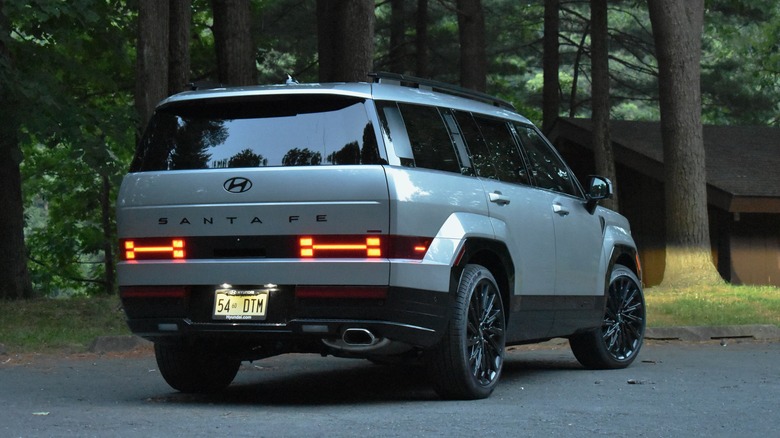
Stephen Edelstein/SlashGear
No vehicle in recent memory has undergone as thorough a transformation as the Santa Fe. Hyundai has taken the styling in a completely different direction, from trying to blend in with more car-like vehicles to trying to copy the look of Land Rovers and Land Cruisers.
Given the Santa Fe’s lack of off-road capability, the boxy shape of the new generation might seem like stolen valor. But Hyundai is simply giving people what they want: a truck-like look without the comprises in packaging, drivability, and efficiency inherent in most true off-roaders. There’s a reason why so many traditional SUVs end up in suburbia rather than Patagonia. People just think they’re cool.
Hyundai also deserves credit for execution. With respect to the Tesla Cybertruck, this is how you do relentlessly angular, 32-bit styling. The design is full of wonderful details, from the neat way the creased fender flares meet up with the headlights and taillights, to the little «H» shape of the lights themselves.
Those lights also give the front end a distinctive and non-aggressive look many current SUVs lack. Whereas many current SUVs (as well as the previous-generation Santa Fe) combine a big grille with stacked headlights for maximum intimidation, this Santa Fe is approachable, like a friendly robot.
Thoughtful interior
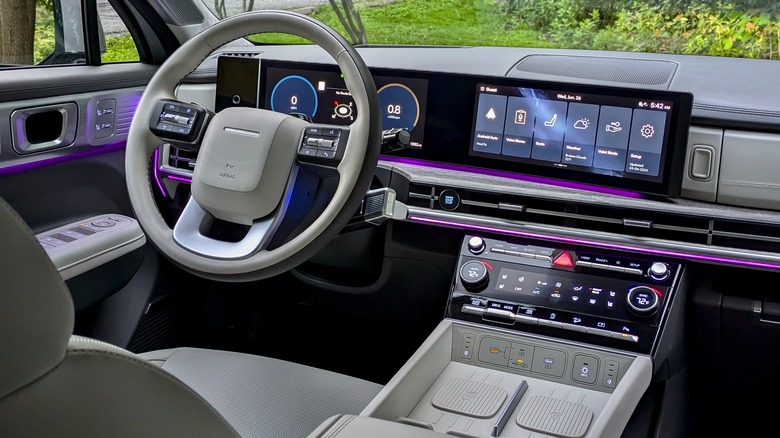
Stephen Edelstein/SlashGear
The design thoughtfulness continues inside, although it seems Hyundai ran out of creative steam (and budget) partway through. The dashboard vents repeat the «H» shape of the exterior lights, and the doors feature large rectangular handles and matching trim pieces that create an appearance of beefiness. The available curved dashboard display reclines into an ident in the dash, and the steering wheel looks vaguely Land Rover-ish.
Even in this top Calligraphy test vehicle, though, materials are definitely Hyundai-grade, not Land Rover. Everything was faultlessly assembled, but what appears to be brushed stainless steel and wood are in fact plastic. Hyundai also couldn’t avoid the trend of using piano black plastic to blend touchscreen surfaces with the surrounding areas, meaning fingerprints and dust might as well be listed as trim elements alongside the plastic wood.
Available purple ambient lighting (you can adjust the color to something less nightclub-like) and light gray upholstery had me thinking of recent Mercedes-Benz models, but the typeface used on the door panels and center console bits had an anodyne appearance that was more airline economy class.
Surplus of storage space
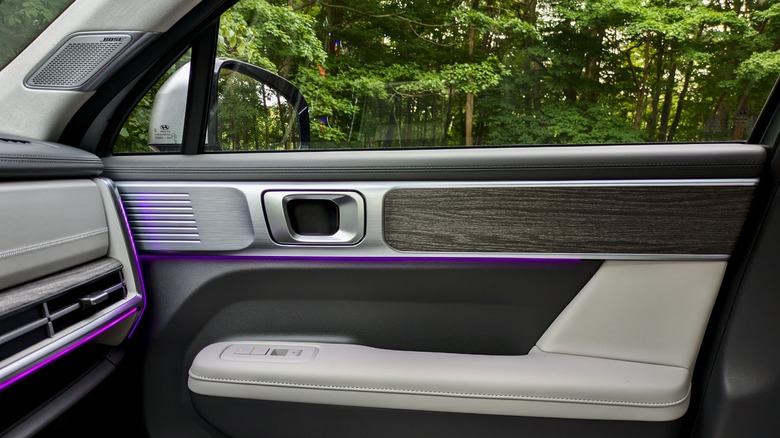
Stephen Edelstein/SlashGear
The interior also makes pockets redundant. The Santa Fe adopts the small ratchet shifter previously seen on the Ioniq EVs and the refreshed 2024 Sonata midsize sedan. It makes room for two prominent wireless charging pads, perfectly placed on an elevated tray that leaves room for a storage nook below.
Gloveboxes aren’t usually a major talking point in new cars, so kudos to Hyundai for getting us to mention this one. It’s actually split into two sections, with a smaller part on top of the dash and a deeper lower section in the usual place. That upper part is handy for stowing smaller items like pens or tire gauges that might otherwise get lost among the owner’s manuals, registration documents, and expired insurance cards in the main glovebox.
Moving further back, the rear doors include no less than three cupholders, with additional cupholders on top of the wheel wells in the third row. Vents and USB ports are crammed back there as well, along with climate controls (albeit only accessible from one seat). Great design takes many forms. Sometimes it’s an aesthetically pleasing bit of sheet metal or a clever aero element. Or in this case, it’s more mundane things like cupholders like acknowledge how a car will actually be used.
Big, but not big enough
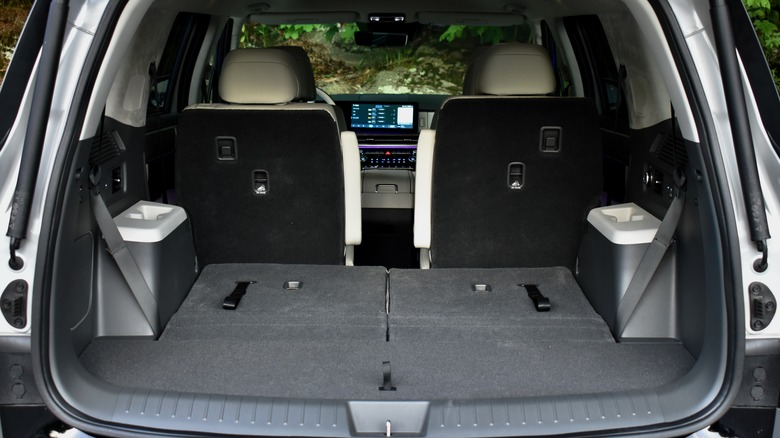
Stephen Edelstein/SlashGear
The 2024 Santa Fe regains the third row that wasn’t available on the previous-generation model. A slight loss of second-row legroom is the likely penalty of that, but Hyundai managed to find about an inch of additional headroom for those seats. First-row headroom and legroom remain roughly the same, with good outward visibility across the flat hood from the driver’s seat.
A low step-in height makes getting into the first- and second-row seats easier (much more so than in the traditional SUVs the Santa Fe’s styling imitates), and this Calligraphy test model’s second-row captain’s chairs were reasonably comfortable. However, getting into the third row requires an awkward step up onto the rear axle hump, and the higher position of the seat bottoms makes for a less comfortable experience. Even smaller adults will find the third row cramped.
Typical for a three-row vehicle, the back seats also don’t leave much cargo space—just 14.6 cubic feet. Fold them down, though, and the new Santa Fe offers 40.5 cubic feet, and that grows to 79.6 cubic feet with the second row folded. Those are substantial increases of 4.1 cubic feet and 7.5 cubic feet, respectively, over the outgoing two-row Santa Fe. The new model’s square back end and low rear bumper also create a wide aperture that makes loading and unloading cargo easier.
While it is a big improvement over the outgoing model, the Santa Fe still trails many other three-row midsize crossovers in cargo space. Some rivals, like the Ford Explorer, Honda Pilot, and Volkswagen Atlas, offer a bit more third-row legroom that makes sitting back there closer to tolerable for adults.
Cutting the cord
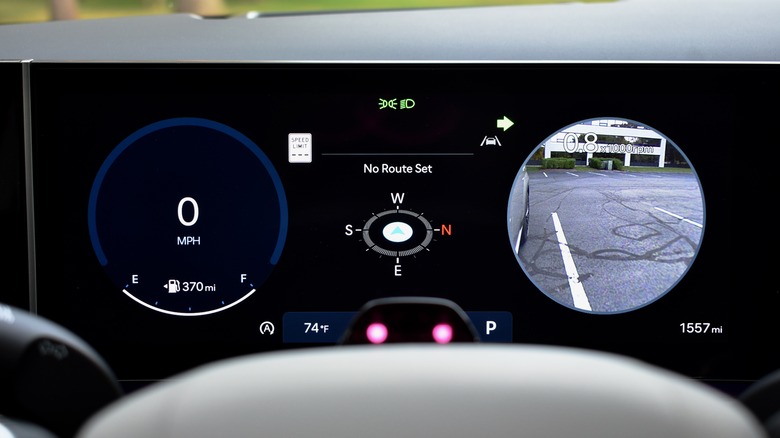
Stephen Edelstein/SlashGear
The infotainment layout follows current industry trends. A 12.3-inch touchscreen is standard, but an optional setup blends the touchscreen and a 12.3-inch digital instrument cluster into one curved display. The more important news here, though, is that wireless Apple CarPlay and Android Auto are supported with both setups. Hyundai (and sibling brand Kia) previously offered wireless connectivity only with smaller entry-level displays. Digital key functionality and over-the-air updates are baked in as well.
The curved display was responsive and easy to navigate, although the graphics reminded me of an app designed for a medical practice. The vacuum tube animation previously used for the radio in certain Hyundai and Kia models is missed. The Santa Fe does at least get Hyundai’s blind-spot camera system—still one of the most useful features of its kind—as well as a digital rearview mirror that eliminates blind spots created by the third row. Helpfully, Hyundai also includes a hard button for camera views as well.
The Santa Fe incorporates the expected array of driver assist features, such as adaptive cruise control and automatic emergency braking, but Hyundai’s most-sophisticated driver aid, Highway Driving Assist, lacks the hands-free capability of the Super Cruise and Blue Cruise systems that will be available on the rival 2024 Chevrolet Traverse and 2025 Ford Explorer, respectively. I also found the lane-keep assist feature to be too sensitive, and ended up turning it off.
Carryover powertrains
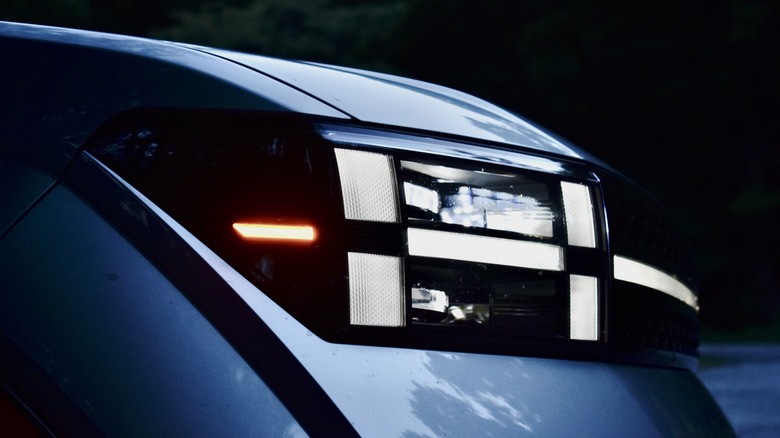
Stephen Edelstein/SlashGear
It says a lot about the current state of internal-combustion vehicles that the least remarkable parts of the new Santa Fe are its powertrain and other mechanical bits.
The exterior design is so noteworthy in part because it’s draped over a version of the unibody platform from the previous-generation model. That platform was introduced partway through the outgoing Santa Fe’s production run, so it’s not stale. But it means that, despite looking dramatically different from most other crossover SUVs, the new Santa Fe isn’t that different underneath.
The spec sheet likely won’t create much excitement, either. Hyundai eliminated the naturally-aspirated 2.5-liter four-cylinder engine that was previously employed in lower trim levels, making the carryover turbocharged 2.5-liter four-cylinder standard. It now makes 277 horsepower instead of the previous 281 hp, but torque remains unchanged at 311 pound-feet. Front-wheel drive and all-wheel drive are available, with an eight-speed dual-clutch transmission in either case.
A hybrid powertrain returns as well, again consisting of a 1.6-liter turbo-four engine with an electric motor integrated with a six-speed automatic transmission like the outgoing version. Output has risen to 231 hp and 271 lb-ft of torque, but fuel economy ratings hadn’t been confirmed at press time. No announcement has been made yet, but a plug-in hybrid powertrain as in the 2023 Santa Fe may return as well, especially considering that this option continues in the related Kia Sorento.
Upscale driving experience
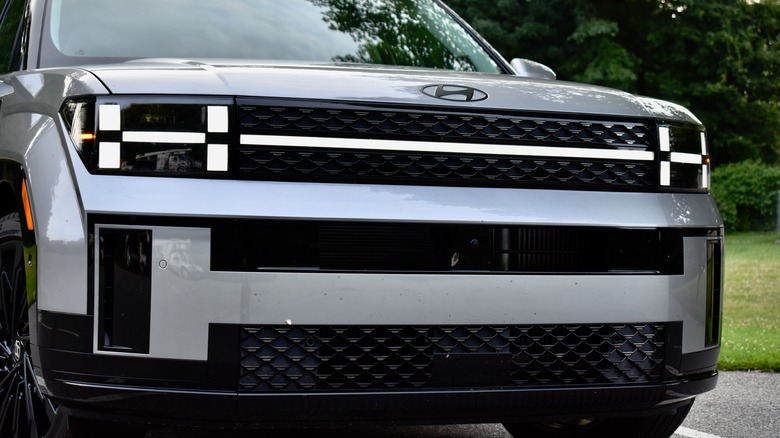
Stephen Edelstein/SlashGear
Boring bits can still make for a pleasant driving experience, though. At highway speeds, this Santa Fe Calligraphy test model was remarkably quiet for a non-luxury vehicle. It also rode well despite 21-inch wheels, keeping construction-scarred pavement from ruining our motoring. It begs the question of whether it’s worth upgrading to a luxury-brand Lexus RX, let alone supposedly more «premium» fare like the Buick Enclave.
Handling is also on the luxury-vehicle side, in that the Santa Fe prioritizes getting through corners comfortably rather than quickly. That’s more appropriate for this vehicle’s mission though; fast cornering is only fun for the driver, and this case that person is decisively outnumbered. The suspension also did a good job of keeping body roll in check, and the steering was precise and communicative, making the Santa Fe feel reasonably nimble for a three-row crossover.
The turbocharged 2.5-liter engine in this non-hybrid test car was eager to show that four cylinders are enough. Power was delivered in a well-mannered and consistent way, as if Hyundai engineers were still reading old automotive journalist rants about turbo lag while tuning the power band. Unfortunately the turbo-four was let down by the transmission, which had trouble shifting smoothly at low speeds. It simply wouldn’t react when pulling away from a stop, creating an uncomfortable pause between throttle application and actual movement.
2024 Hyundai Santa Fe Verdict
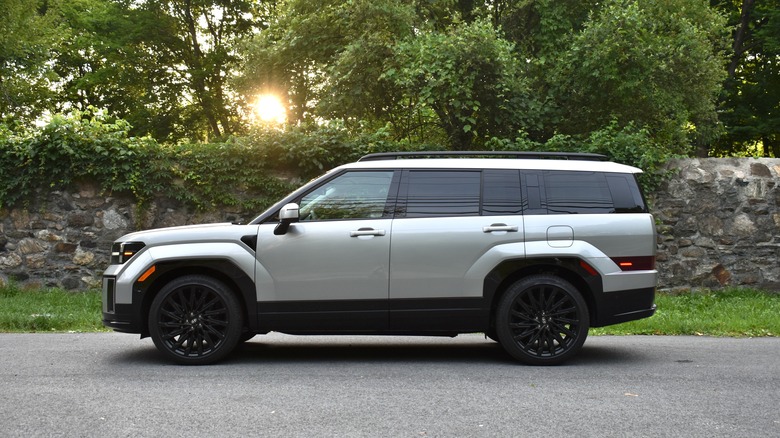
Stephen Edelstein/SlashGear
The Santa Fe is no longer quite the great value that the original version was, but it’s not excessively pricy either. A base SE model with front-wheel drive and cloth seats starts at $35,345, while a range-topping leather-upholstered all-wheel drive Calligraphy comes close to $50,000. Prices are up a bit from the previous generation, but well within normal range for this market segment.
A well-executed interior with lots of small-item storage, as well as an updated infotainment system that finally allows for wireless Apple CarPlay and Android Auto with the bigger optional display should make the 2024 Santa Fe easier to live with. Bringing back the third row seems pointless though, except for car shoppers with small children. And the ill-mannered dual-clutch transmission stains what is otherwise a very pleasant driving experience.
These details may sway some shoppers to other brands, but many are likely to forget that the Honda Pilot or Toyota Highlander exist after they’re first look at the Hyundai’s chiseled visage. Hyundai deserves credit for committing to the bit. Rival crossovers look somewhat rugged but still remind you that they’re car-based mall crawlers in the name of authenticity. Hyundai doesn’t have a proud off-road heritage to despoil; it can afford to be inauthentic. And if that doesn’t work, it can always try something else.